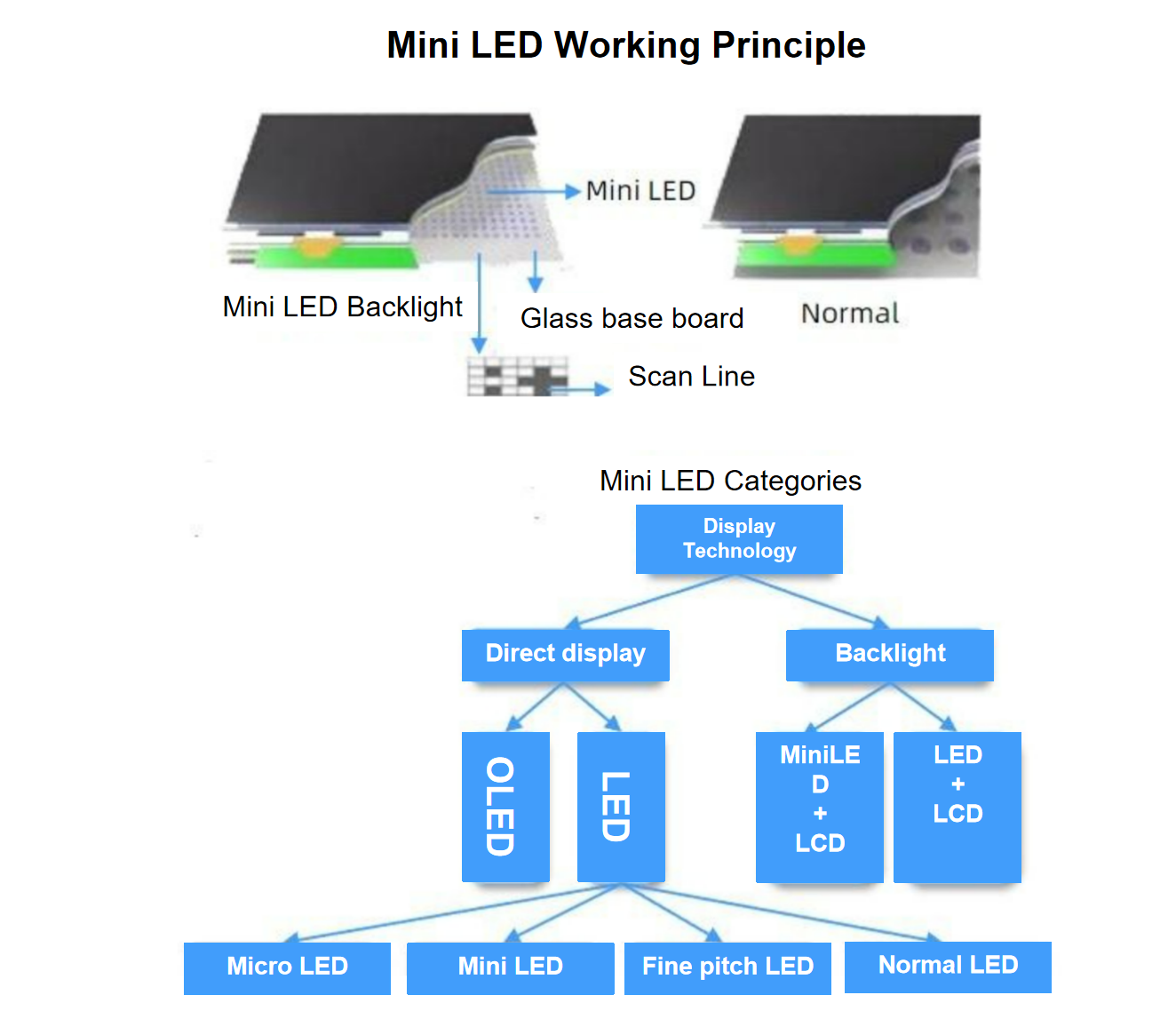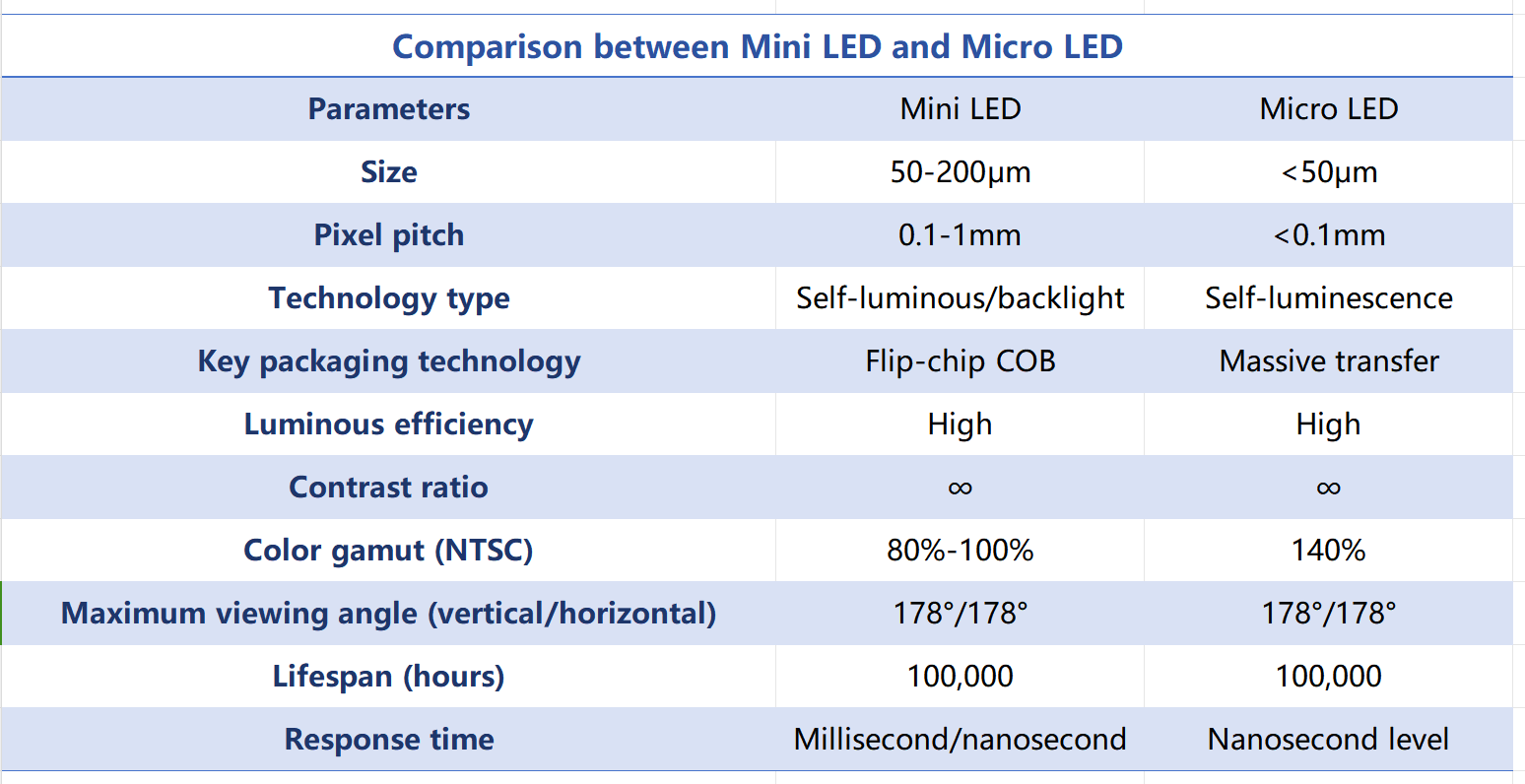Mini-LED and micro-LED are considered to be the next big trend in display technology. They have a wide range of application scenarios in various electronic devices, are becoming more and more popular among users, and related companies are also continuously increasing their capital investment.
What is Mini-LED?
Mini-LED is usually around 0.1mm in length, and the industry default size range is between 0.3mm and 0.1mm. Small size means smaller light points, higher dot density, and smaller light control areas. Moreover, these tiny Mini-LED chips can have high brightness.
The so-called LED is much smaller than ordinary LEDs. This Mini LED can be used to make color displays. The smaller size makes them cost-effective and reliable, and Mini LED consumes less energy.
What is Micro-LED?
Micro-LED is a chip that is smaller than Mini-LED, usually defined as less than 0.05mm.
Micro-LED chips are much thinner than OLED displays. Micro-LED displays can be made very thin. Micro-LEDs are usually made of gallium nitride, which has a longer lifespan and is not easily worn. The microscopic nature of Micro-LEDs allows them to achieve very high pixel densities, producing clear images on the screen. With its high brightness and high-quality display, it easily outperforms OLED in various performance aspects.
The main differences between Mini LED and Micro LED
★ Difference in size
· Micro-LED is much smaller than Mini-LED.
· Micro-LED is between 50μm and 100μm in size.
· Mini-LED is between 100μm and 300μm in size.
· Mini-LED is usually one-fifth the size of a normal LED.
· Mini LED is very suitable for backlighting and local dimming.
· Micro-LED has a microscopic size with high pixel brightness.
★ Differences in brightness and contrast
Both LED technologies can achieve very high brightness levels. Mini LED technology is usually used as LCD backlight. When doing backlighting, it is not single-pixel adjustment, so its microscopicity is limited by the backlight requirements.
Micro-LED has an advantage in that each pixel controls the light emission individually.
★ Difference in color accuracy
While Mini-LED technologies allow for local dimming and excellent color accuracy, they cannot compare to Micro-LED. Micro-LED is single-pixel controlled, which helps reduce color bleed and ensures accurate display, and the color output of the pixel can be easily adjusted.
★ Differences in thickness and form factor
Mini-LED is a backlit LCD technology, so Micro-LED has a larger thickness. However, compared with traditional LCD TVs, it has been much thinner. Micro-LEDm emits light directly from LED chips, so Micro-LED is very thin.
★ Difference in viewing angle
Micro-LED has consistent color and brightness at any viewing angle. This relies on the self-luminous properties of Micro-LED, which can maintain image quality even when viewed from a wide angle.
Mini-LED technology still relies on traditional LCD technology. Although it has greatly improved image quality, it is still difficult to view the screen from a larger angle.
★ Aging issues, differences in lifespan
Mini-LED technology, which still uses LCD technology, is prone to burnout when images are displayed for a long time. However, the burnout problem has been significantly alleviated in recent years.
Micro-LED is currently mainly made of inorganic materials with gallium nitride technology, so it has little risk of burnout.
★ Differences in structure
Mini-LED uses LCD technology and consists of a backlight system and an LCD panel. Micro-LED is a completely self-luminous technology and does not require a backplane. The manufacturing cycle of Micro-LED is longer than that of Mini-LED.
★ Difference in pixel control
Micro-LED is made up of tiny individual LED pixels, which can be precisely controlled due to their tiny size, resulting in better picture quality than mini-LED. Micro-LED can turn off lights individually or completely when necessary, making the screen appear perfectly black.
★ Difference in application flexibility
Mini-LED uses a backlight system, which limits its flexibility. Although thinner than most LCDs, Mini-LEDs still rely on backlights, which makes their structure inflexible. Micro-LEDs, on the other hand, are highly flexible because they do not have a backlight panel.
★ Difference in Manufacturing Complexity
Mini-LEDs are simpler to manufacture than Micro-LEDs. Since they are similar to traditional LED technology, their manufacturing process is compatible with existing LED production lines. The entire process of manufacturing Micro-LEDs is demanding and time-consuming. The extremely small size of Mini-LEDs makes them extremely difficult to operate. The number of LEDs per unit area is also much greater, and the process required for operation is also longer. Therefore, Mini-LEDs are currently ridiculously expensive.
★ Micro-LED vs. Mini-LED: Cost Difference
Micro-LED screens are too expensive! It is still in the development stage. Although Micro-LED technology is exciting, it is still unacceptable for ordinary users. Mini-LED is more affordable, and its cost is slightly higher than OLED or LCD TVs, but the better display effect makes it acceptable to users.
★ Difference in efficiency
The small size of the pixels of Micro-LED displays enables the technology to achieve higher display levels while maintaining sufficient power consumption. Micro-LED can turn off pixels, improve energy efficiency and higher contrast.
Relatively speaking, the power efficiency of Mini-LED is lower than that of Micro-LED.
★ Difference in Scalability
The scalability mentioned here refers to the ease of adding more units. Mini-LED is relatively easy to manufacture due to its relatively large size. It can be adjusted and expanded without many adjustments to the predefined manufacturing process.
On the contrary, Micro-LED is much smaller in size, and its manufacturing process is much more difficult, time-consuming and very expensive to handle. This may be because the relevant technology is relatively new and not mature enough. I hope that this situation will change in the future.
★ Difference in response time
Mini-LED has good response time and smooth performance. Micro-LED has a faster response time and less motion blur than Mini-LED.
★ Difference in lifespan and reliability
In terms of service life, Micro-LED is better. Because Micro-LED consumes less power and has a lower risk of burnout. And the smaller size is good for improving image quality and response speed.
★ Differences in Applications
The two technologies differ in their applications. Mini-LED is mainly used in large displays that require backlighting, while Micro-LED is used in smaller displays. Mini-LED is often used in displays, large-screen TVs, and digital signage, while micro-LED is often used in small technologies such as wearables, mobile devices, and custom displays.
Conclusion
As mentioned before, there is no technical competition between Mni-LED and Micro-LED, so you don’t have to choose between them, they are both aimed at different audiences. Apart from some of their shortcomings, the adoption of these technologies will bring a new dawn to the display world.
Micro-LED technology is relatively new. With the continuous evolution and advancement of its technology, you will use Micro-LED’s high-quality picture effects and light and convenient experience in the near future. It may make your mobile phone a soft card, or the TV at home is just a piece of cloth or decorative glass.
Post time: May-22-2024







